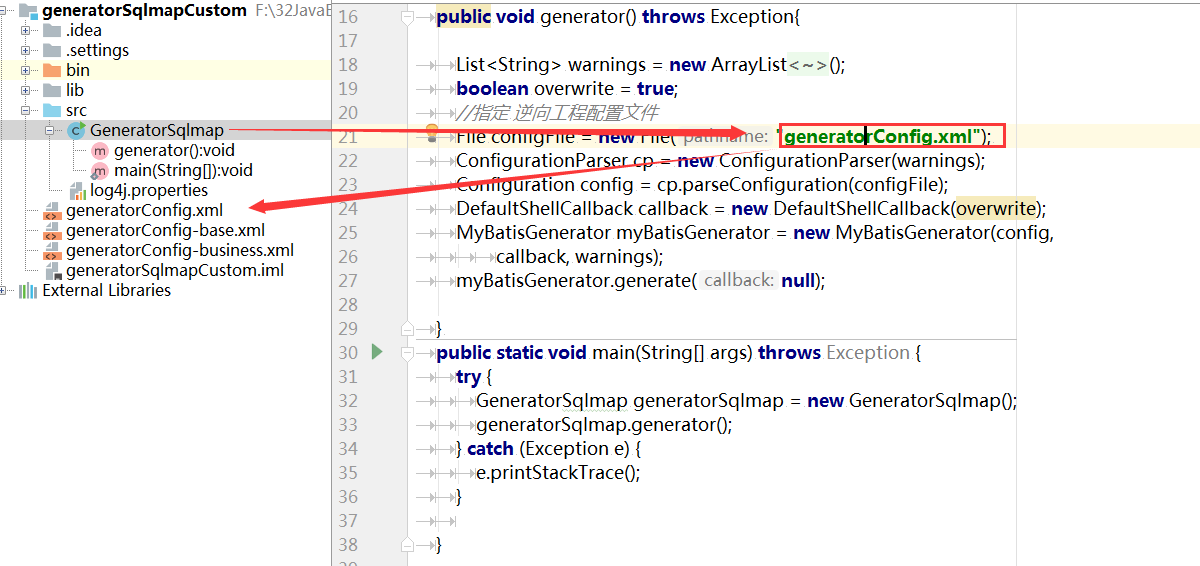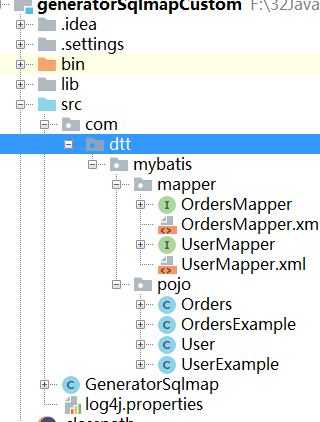一, 前一篇博客中,介绍了一下Mybatis和hibernate的对比,在这一篇博客说说mybatis的逆向工程,展示一下,只要有一个数据库,你的持久层,你的D层从此不用你自己手写了。
二、什么是逆向工程?
mybaits需要程序员自己编写sql语句,mybatis官方提供逆向工程 可以针对单表自动生成mybatis执行所需要的代码(mapper.java,mapper.xml、pojo),企业实际开发中,常用的逆向工程方式:由于数据库的表生成java代码。
三、Mybatis中逆向工程的使用
导入
- 导入已有的数据库,小编已经导入自己编写好的数据库,数据库结构如下:

把generatorSqlmapCustom JavaProject导入

修改配置文件的数据库连接以及数据库

指定数据库表

生成表对应的实体类
<javaModelGenerator targetPackage="com.dtt.mybatis.pojo" targetProject=".src"> <!-- enableSubPackages:是否让schema作为包的后缀 --> <property name="enableSubPackages" value="false" /> <!-- 从数据库返回的值被清理前后的空格 --> <property name="trimStrings" value="true" /> </javaModelGenerator>
mapper映射文件生成
<!-- targetProject:mapper映射文件生成的位置 --> <sqlMapGenerator targetPackage="com.dtt.mybatis.mapper" targetProject=".src"> <!-- enableSubPackages:是否让schema作为包的后缀 --> <property name="enableSubPackages" value="false" /> </sqlMapGenerator>
mapper接口生成
<!-- targetPackage:mapper接口生成的位置 --> <javaClientGenerator type="XMLMAPPER" targetPackage="com.dtt.mybatis.mapper" targetProject=".src"> <!-- enableSubPackages:是否让schema作为包的后缀 --> <property name="enableSubPackages" value="false" /> </javaClientGenerator>
几个关键属性:
javaModelGenerator :实体类生成;
sqlMapGenerator :映射文件生成;
javaClientGenerator :接口生成;
targetProject:生成文件的位置,本例中.src,是指src下的目录;
targetPackage:生成包的名称;
修改完成后,运行GeneratorSqlmap.java中的main方法,就可以生成。

以User表为例,展示生成的代码:
- User.java
package com.dtt.mybatis.pojo; import java.util.Date; public class User { private Integer id; private String username; private Date birthday; private String sex; private String address; public Integer getId() { return id; } public void setId(Integer id) { this.id = id; } public String getUsername() { return username; } public void setUsername(String username) { this.username = username == null ? null : username.trim(); } public Date getBirthday() { return birthday; } public void setBirthday(Date birthday) { this.birthday = birthday; } public String getSex() { return sex; } public void setSex(String sex) { this.sex = sex == null ? null : sex.trim(); } public String getAddress() { return address; } public void setAddress(String address) { this.address = address == null ? null : address.trim(); } }- UserMapper.java
这里生成了所有的增删改查的sql语句,调用的时候就直接使用对应的方法就可以了很方便吧。(重点学习一下自动生成的代码是如何封装的)
package com.dtt.mybatis.mapper; import com.dtt.mybatis.pojo.User; import com.dtt.mybatis.pojo.UserExample; import java.util.List; import org.apache.ibatis.annotations.Param; public interface UserMapper { int countByExample(UserExample example); int deleteByExample(UserExample example); int deleteByPrimaryKey(Integer id); int insert(User record); int insertSelective(User record); List<User> selectByExample(UserExample example); User selectByPrimaryKey(Integer id); int updateByExampleSelective(@Param("record") User record, @Param("example") UserExample example); int updateByExample(@Param("record") User record, @Param("example") UserExample example); int updateByPrimaryKeySelective(User record); int updateByPrimaryKey(User record); }UserMapper.xml
<?xml version="1.0" encoding="UTF-8" ?> <!DOCTYPE mapper PUBLIC "-//mybatis.org//DTD Mapper 3.0//EN" "http://mybatis.org/dtd/mybatis-3-mapper.dtd" > <mapper namespace="com.dtt.mybatis.mapper.UserMapper" > <resultMap id="BaseResultMap" type="com.dtt.mybatis.pojo.User" > <id column="id" property="id" jdbcType="INTEGER" /> <result column="username" property="username" jdbcType="VARCHAR" /> <result column="birthday" property="birthday" jdbcType="DATE" /> <result column="sex" property="sex" jdbcType="CHAR" /> <result column="address" property="address" jdbcType="VARCHAR" /> </resultMap> <sql id="Example_Where_Clause" > <where > <foreach collection="oredCriteria" item="criteria" separator="or" > <if test="criteria.valid" > <trim prefix="(" suffix=")" prefixOverrides="and" > <foreach collection="criteria.criteria" item="criterion" > <choose > <when test="criterion.noValue" > and ${criterion.condition} </when> <when test="criterion.singleValue" > and ${criterion.condition} #{criterion.value} </when> <when test="criterion.betweenValue" > and ${criterion.condition} #{criterion.value} and #{criterion.secondValue} </when> <when test="criterion.listValue" > and ${criterion.condition} <foreach collection="criterion.value" item="listItem" open="(" close=")" separator="," > #{listItem} </foreach> </when> </choose> </foreach> </trim> </if> </foreach> </where> </sql> <sql id="Update_By_Example_Where_Clause" > <where > <foreach collection="example.oredCriteria" item="criteria" separator="or" > <if test="criteria.valid" > <trim prefix="(" suffix=")" prefixOverrides="and" > <foreach collection="criteria.criteria" item="criterion" > <choose > <when test="criterion.noValue" > and ${criterion.condition} </when> <when test="criterion.singleValue" > and ${criterion.condition} #{criterion.value} </when> <when test="criterion.betweenValue" > and ${criterion.condition} #{criterion.value} and #{criterion.secondValue} </when> <when test="criterion.listValue" > and ${criterion.condition} <foreach collection="criterion.value" item="listItem" open="(" close=")" separator="," > #{listItem} </foreach> </when> </choose> </foreach> </trim> </if> </foreach> </where> </sql> <sql id="Base_Column_List" > id, username, birthday, sex, address </sql> <select id="selectByExample" resultMap="BaseResultMap" parameterType="com.dtt.mybatis.pojo.UserExample" > select <if test="distinct" > distinct </if> <include refid="Base_Column_List" /> from user <if test="_parameter != null" > <include refid="Example_Where_Clause" /> </if> <if test="orderByClause != null" > order by ${orderByClause} </if> </select> <select id="selectByPrimaryKey" resultMap="BaseResultMap" parameterType="java.lang.Integer" > select <include refid="Base_Column_List" /> from user where id = #{id,jdbcType=INTEGER} </select> <delete id="deleteByPrimaryKey" parameterType="java.lang.Integer" > delete from user where id = #{id,jdbcType=INTEGER} </delete> <delete id="deleteByExample" parameterType="com.dtt.mybatis.pojo.UserExample" > delete from user <if test="_parameter != null" > <include refid="Example_Where_Clause" /> </if> </delete> <insert id="insert" parameterType="com.dtt.mybatis.pojo.User" > insert into user (id, username, birthday, sex, address) values (#{id,jdbcType=INTEGER}, #{username,jdbcType=VARCHAR}, #{birthday,jdbcType=DATE}, #{sex,jdbcType=CHAR}, #{address,jdbcType=VARCHAR}) </insert> <insert id="insertSelective" parameterType="com.dtt.mybatis.pojo.User" > insert into user <trim prefix="(" suffix=")" suffixOverrides="," > <if test="id != null" > id, </if> <if test="username != null" > username, </if> <if test="birthday != null" > birthday, </if> <if test="sex != null" > sex, </if> <if test="address != null" > address, </if> </trim> <trim prefix="values (" suffix=")" suffixOverrides="," > <if test="id != null" > #{id,jdbcType=INTEGER}, </if> <if test="username != null" > #{username,jdbcType=VARCHAR}, </if> <if test="birthday != null" > #{birthday,jdbcType=DATE}, </if> <if test="sex != null" > #{sex,jdbcType=CHAR}, </if> <if test="address != null" > #{address,jdbcType=VARCHAR}, </if> </trim> </insert> <select id="countByExample" parameterType="com.dtt.mybatis.pojo.UserExample" resultType="java.lang.Integer" > select count(*) from user <if test="_parameter != null" > <include refid="Example_Where_Clause" /> </if> </select> <update id="updateByExampleSelective" parameterType="map" > update user <set > <if test="record.id != null" > id = #{record.id,jdbcType=INTEGER}, </if> <if test="record.username != null" > username = #{record.username,jdbcType=VARCHAR}, </if> <if test="record.birthday != null" > birthday = #{record.birthday,jdbcType=DATE}, </if> <if test="record.sex != null" > sex = #{record.sex,jdbcType=CHAR}, </if> <if test="record.address != null" > address = #{record.address,jdbcType=VARCHAR}, </if> </set> <if test="_parameter != null" > <include refid="Update_By_Example_Where_Clause" /> </if> </update> <update id="updateByExample" parameterType="map" > update user set id = #{record.id,jdbcType=INTEGER}, username = #{record.username,jdbcType=VARCHAR}, birthday = #{record.birthday,jdbcType=DATE}, sex = #{record.sex,jdbcType=CHAR}, address = #{record.address,jdbcType=VARCHAR} <if test="_parameter != null" > <include refid="Update_By_Example_Where_Clause" /> </if> </update> <update id="updateByPrimaryKeySelective" parameterType="com.dtt.mybatis.pojo.User" > update user <set > <if test="username != null" > username = #{username,jdbcType=VARCHAR}, </if> <if test="birthday != null" > birthday = #{birthday,jdbcType=DATE}, </if> <if test="sex != null" > sex = #{sex,jdbcType=CHAR}, </if> <if test="address != null" > address = #{address,jdbcType=VARCHAR}, </if> </set> where id = #{id,jdbcType=INTEGER} </update> <update id="updateByPrimaryKey" parameterType="com.dtt.mybatis.pojo.User" > update user set username = #{username,jdbcType=VARCHAR}, birthday = #{birthday,jdbcType=DATE}, sex = #{sex,jdbcType=CHAR}, address = #{address,jdbcType=VARCHAR} where id = #{id,jdbcType=INTEGER} </update> </mapper>小结
逆向工程在很多软件里面都有,比如EA的逆向工程,PB的逆向工程。还有很多,总之,这个就是其中的一些很有价值的东西,在企业运用的时候很方便,而且这些生成好的类,尽量不要去修改,如果非要修改的话,可以用pv类来实现继承拓展。这是很好的选择。